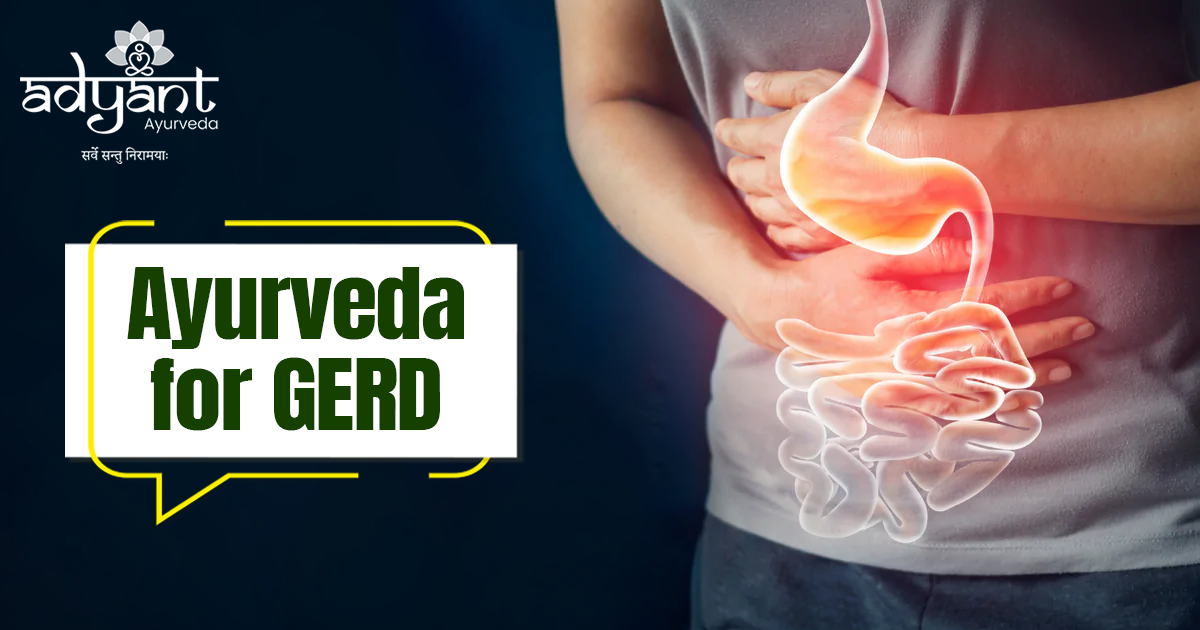
GERD Treatment in Ayurveda: Have you ever felt burning sensations in your chest or around your heart an hour or so after eating? Have you ever felt something hot rising in your stomach and towards your heart and throat?
Don’t worry if you get it now and then; we all do. However, if you have it frequently, you should consult your doctor, you might be suffering from a disease known as gastro-oesophageal reflux (GERD).
Ayurveda describes GERD as “Amlapitta,” which means the Pitta dosha component of the body that governs digestion has excess acidic levels, resulting in acid reflux and heartburn – Hrit Daha – as well as a bitter taste in the mouth – Tikta Udgara – and indigestion – Avipaka. As the concentration of acids in the gastrointestinal system stays high, the Kapha and Vata doshas are impeding, causing discomforting symptoms such as nausea, vomiting, bad breath/halitosis, chest pain, and trouble swallowing food, known as dysphagia.
Click Here: For a Free Consultation
If you suffer heartburn more than twice a week and it doesn’t go away with over-the-counter antacids, you may have GERD. Thousands of acid reflux patients have received long-term relief from our GERD Treatment in Ayurveda at Adyant Ayurveda from the best Ayurvedic doctors in Bangalore. Initially, some dietary and lifestyle adjustments, as well as Ayurveda treatments are recommended.
Table of Contents
ToggleGERD Treatment in Ayurveda: Risk Factors for Acid Reflux / GERD
There are various risk factors for having GERD. And GERD Treatment in Ayurveda easily cures it with some herbal remedies and Ayurvedic treatments. Some of the risk factors are given below:
| S. No. | Risk Factors |
| 1 | Obesity |
| 2 | Pregnancy |
| 3 | Hiatal hernia |
| 4 | Alcohol consumption |
| 5 | Constipation |
| 6 | Smoking |
| 7 | Eating large meals at night |
| 8 | Consumption of spicy and fatty foods at night |
| 9 | Excess consumption of coffee, tea, etc |
| 10 | Certain drugs, such as aspirin, painkillers |
GERD Treatment in Ayurveda: Complications of Acid Reflux
if you have GERD then you must know what complications you will face. GERD Treatment in Ayurveda at Adyant Ayurveda provides you with the best treatment for it. Below we have mentioned some complications of Acid Reflux or GERD:
Oesophageal stenosis is a condition in which the oesophagus narrows (oesophageal structure) as a result of scar tissue development caused by stomach acid injury to the lower oesophagus. The scar tissue narrows the food path, making swallowing harder.
An unexplained oesophageal sore (oesophageal ulcer). Stomach acid can cause oesophageal tissue destruction, resulting in an open sore and pain. An oesophageal ulcer causes bleeding, pain, and trouble swallowing.
Barrett’s oesophagus is a precancerous oesophageal modification in which acid damage causes anomalies in the tissue that lines the lower oesophagus, resulting in the creation of scar tissues. Scar tissue production has been related to an increased risk of oesophageal cancer.
You May Also Like: Ayurvedic Treatment for Hyperacidity
GERD Treatment in Ayurveda: Herbal Remedies
Pippali
Pippali, also known as Long Pepper, is a tried-and-tested herbal remedy used for GERD Treatment in Ayurveda for acid reflux and GERD. To relieve heartburn, the spice has potent chemicals that accelerate digestion and balance the Pitta doshas in the system. To effectively treat GERD symptoms, combine 1 tsp pippali powder with a touch of honey in a glass of warm water and drink the decoction after meals.
Tulsi
Tulsi, often known as Holy Basil, is an effective natural cure for a variety of gastrointestinal problems, including GERD. The leaves of this holy plant contain volatile oils that have powerful carminative properties and can help reduce flatulence, gas, and hyperacidity. During GERD Treatment in Ayurveda, you need to Sip a cup of hot Tulsi tea after a full meal at breakfast, lunch, or supper to aid digestion and soothe burning feelings in the gut.
Elaichi
Elaichi Cardamom, also known as elaichi is used in GERD Treatment in Ayurveda. It is high in B vitamins and antioxidants, which help to promote metabolism and aid with digestion. Antioxidants, help to stimulate metabolism and facilitate digestion. The fragrant pods also help alleviate nausea, bloating, and a bitter taste in the mouth, which are common symptoms of GERD. Chew on several elaichi/cardamom pods after eating to stimulate the digestive fluids and aid in adequate nutritional absorption inside the system.
Gourd (Ash Gourd)
Ash gourd is a nutritious green vegetable that is high in water content and high in phytonutrients such as terpenes and flavonoids, which assist in reducing acid levels in the gut and prevent nausea, vomiting, and constipation. To effectively control GERD, drink a glass of ash gourd juice in the morning to help with digestion, acid reflux, and heartburn.
Learn More: Ayurvedic Home Remedies for Constipation
GERD Treatment in Ayurveda: Forms of GERD Amalapitta
During GERD Ayurveda treatment, you should know how many forms are there in GERD or Amalapitta. GERD or Amlapitta exists in two forms and how to recognize is listed below:
| Amalapitta Forms | How to recognized |
| Urdhwagami Amlapitta | Urdhwag Amlapitta is where the vitiated pitta dosha moves upwards |
| Adhogami Amlapitta | Vitiated pitta moves downwards |
Among Urdhwagami and Adhogami Amlapitta, Urdhwagami Amlapitta closely resembles GERD symptoms.
GERD Treatment in Ayurveda: Role of Panchakarma
- Deep Detoxification: Panchakarma therapy works on a deep cellular level, targeting the root cause of GERD. By eliminating toxins and accumulated ama (undigested waste), it helps to cleanse and purify the digestive system, reducing the frequency and intensity of acid reflux episodes.
- Restoring Dosha Balance: According to Ayurveda, GERD is primarily caused by an imbalance in the pitta dosha, which represents fire and water elements in the body. GERD Treatment in Ayurveda such as Panchakarma treatments, includes Vamana and Virechana, which help pacify the aggravated pitta dosha. Thus bringing it back into balance and minimizing acid reflux symptoms.
- Enhancing Digestive Function: Panchakarma therapies promote healthy digestion by stimulating the agni (digestive fire) and improving gut motility. This optimizes the absorption and assimilation of nutrients while preventing the backflow of stomach acid into the esophagus.
- Stress Management: Chronic stress has been linked to GERD flare-ups. GERD Treatment in Ayurveda such as Panchakarma treatments, including Nasya and Basti, have a calming effect on the nervous system, reducing stress and anxiety levels. By addressing the underlying emotional factors contributing to GERD, Panchakarma can provide comprehensive relief.
- Supporting Tissue Repair: GERD can lead to esophageal tissue damage and erosion. Panchakarma therapies, promote tissue healing and regeneration, accelerating the recovery process and preventing further complications.
Read More:- Panchakarma: The Complete Guide
Additional Ayurvedic Approaches for GERD Relief
In conjunction with Panchakarma treatment, certain lifestyle modifications and Ayurvedic remedies can further enhance the management of GERD Treatment in Ayurveda. These include:
- Dietary Recommendations: Following a Pitta-pacifying diet that includes cooling and soothing foods, such as fresh fruits, vegetables, whole grains, and herbal teas, can help alleviate GERD symptoms.
- Limiting spicy, fried, and acidic foods can reduce acid reflux episodes.
- Avoiding caffeine, alcohol, and tobacco can prevent further irritation to the esophagus.
- Herbal Supplements: GERD Treatment in Ayurveda done through Ayurvedic herbs like licorice (Glycyrrhiza glabra), Amla (Emblica officinalis), and Haritaki (Terminalia chebula) have been found to provide relief from GERD symptoms. These herbs can be consumed in various forms, including capsules, powders, or herbal teas, after consulting with an experienced Ayurvedic practitioner at Adyant Ayurveda.
- Stress Reduction Techniques: Incorporating stress management practices like yoga, meditation, and deep breathing exercises can help alleviate anxiety and promote relaxation, indirectly reducing the frequency of GERD flare-ups.
Read More: Ayurvedic Treatment for Anxiety and Stress
Ayurvedic Treatment for GERD
The GERD Treatment in Ayurveda should be done along the lines of Amlapitta therapy. The major goal is to get rid of the morbid Pitta while also protecting the stomach and gut from Pitta’s effect. Following the administration of Vamana (Therapeutic Emesis) and Virechana (Therapeutic Purgation) to remove morbid Pitta and Kapha, oral drugs depending on Prakriti (physical constitution) and Vikriti (quality and quantity of morbidity) are given as a follow-up. Rasayanas (disease modifiers and rejuvenators) are provided after the disease has been managed to eradicate residual disease and offer long-term protection against the disease.
GERD Ayurveda Treatment: Diet (Pathya and Apathya)
Pathya is utilized in Panchakarma to restore the vitiated Annavaha Srotas (digestive system) and Purishavaha Srotas (excretory system) to a healthy state. Pathya assists patients in keeping their dhatus (fundamental components) in a healthy state, reducing dosha imbalance. Pathya helps healthy people to stay active, and it is recommended that patients maintain their channels in good shape.
Apathya (unwholesome foods ) that cause or trigger the symptoms of GERD are advised to avoid. GERD Treatment in Ayurveda has several tried-and-true formulations and therapies for GERD and other gut-related issues. GERD becomes more difficult with time if proper GERD Ayurveda treatment is not taken. If you have heartburn, which is persistent for a long, then see your Ayurvedic doctor for comprehensive care.
Read More: Ayurvedic Doshas: Vata, Kapha, Pitta
Conclusion
GERD Treatment in Ayurveda has Panchakarma treatment which offers a holistic and natural approach to managing GERD. By addressing the root cause of the condition. Through deep detoxification, dosha balance restoration, enhanced digestion, stress management, and tissue repair, Panchakarma therapies can provide long-term relief and prevent further complications associated with GERD. Alongside lifestyle modifications and Ayurvedic remedies, this ancient therapy opens up new possibilities for individuals seeking effective and sustainable GERD treatment without relying solely on conventional medications.
Read Other Related Blogs:





